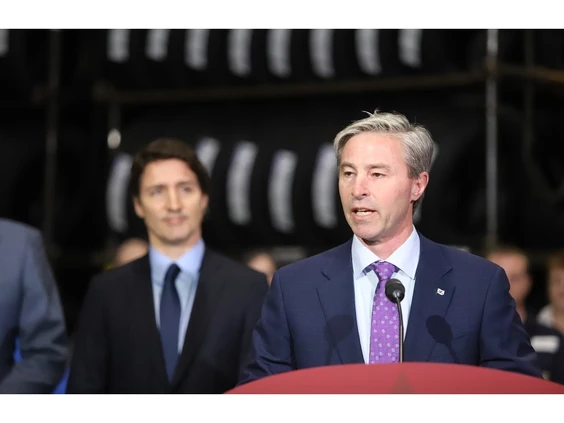-
play_arrow
KISS FM Nova Scotia

Prime Minister Justin Trudeau and Nova Scotia Premier Tim Houston make a funding announcement at the Michelin plant in Bridgewater on March 14, 2023. PHOTO BY TIM KROCHAK
lready stretched financially, Nova Scotians are now facing a tariff war.
It will hurt us all.
If U.S. president-elect Donald Trump follows through on his plan to put a 25 per cent tariff on Canadian products when he takes office this month, the impact will spread from grocery store aisles to wharves.
The effects on highly integrated North American supply chains are hard to quantify, with many products, including our food, often crossing back and forth across borders before reaching consumers.
Here’s a rough look at what it’ll mean for Nova Scotians.
Groceries
Canada’s Food Price Report released last month already predicted the average family will pay three to five per cent more for groceries in 2025 over last year. For a family of four, that’ll mean paying an extra $801 for groceries.
“But we didn’t consider the tariff threats factor or think that was going to happen,” said Sylvain Charlebois, director of Dalhousie University’s Agri-Food Analytics Lab that published the report.
“It would be devastating to Canada’s agri-food industry.”
While Canada is a massive producer — exporting $99.1-billion worth of agriculture and food products in 2023 — that won’t protect consumers.
Much of what we produce crosses into the United States to be processed or used as ingredients, where it would be tariffed on the way, if it is bought at all, before coming back to us.
Through the winter months, we rely on imports of a tremendous amount of produce from warmer American states.
If the Canadian government found a way to retaliate with counter-tariffs despite Parliament being prorogued, as in previous tariff battles they would likely select high-end non-staples produced in regions with Republican congressmen likely to pressure the president.
The loonie
But even if we’re not tariffing necessities like groceries, they would still get more expensive because the loonie, already trading low at about 69 U.S. cents Thursday, would take a dive.
“You’d expect the Canadian dollar would depreciate compared to the American, and any imports would be more expensive,” said Greg Tkacz, an economist at St. Francis Xavier University who used to work at the Bank of Canada.
“Their economy is 10 times larger than ours. Any businesses, producers, trying to set up shop somewhere would have to choose the United States because it’s easier to access the larger market. You’d expect more capital to flow south of the border.”
So it wouldn’t just be groceries. Nearly everything would get more expensive.
A lower loonie would act as a shock absorber for exporters. If the American dollar is worth more, then some of a tariff’s bite would be ameliorated by its increased relative buying power.
Lobster, trees and tires
The United States is by far Nova Scotia’s largest trading partner.
In 2022, we exported $3.282-billion worth of goods south of the border and imported $470-million worth of American products.
At $937 million, rubber products, primarily tires from Michelin’s plants in Pictou County, Waterville and Bridgewater, were the top export.
Seafood came in second at $819 million, mineral fuels at $317 million and wood products at $175 million.
Nova Scotia’s most valuable fisheries are currently open in lobster fisheries areas 33 and 34 around the South Shore and into the Bay of Fundy.
Americans buy about 30-40 per cent of that lobster, down from 80 per cent 20 years ago.
Stewart Lamont, owner of Tangier Lobster, warned that having 50 per cent of our lobster going to Asia won’t provide as much protection as one would hope from American tariffs.
“China follows all this chapter and verse,” said Lamont.
“If we had to pivot and move more to China, they would expect a further price discount. It’s a global market; it’s very visible what companies and sectors are doing.”
With buyers and processors already operating on “the thinnest margins in history,” Lamont said a decreased price would largely translate down to what is paid to fishermen (currently around $12.50 a pound).
Michelin’s not the only producer of tires; the United States has other manufacturers that won’t be tariffed.
This province’s sawmills and Port Hawkesbury Paper are already working on thin margins to compete in the American market.
Pressure and time
The key, said Tkacz, is the length of the tariff war.
If Trump keeps them up, he will damage the American economy, too. But due to the size differential, Canadians will feel it worse.
With a ballooning federal deficit, estimated just before Christmas to be at over $60 billion for 2024, the federal government is also in a poor position to borrow to prop up the economy through stimulus.
Tkacz said that “chaos in Ottawa” further damages Canada’s position.
“Leadership is extremely important,” said Tkacz.
“You need someone who has the ear of the president. Back in 2018-19, we had (former prime minister) Brian Mulroney in Florida talking to (president) Donald Trump directly. He’s not there. Donald Trump doesn’t care too much for Canada’s current leadership. Who’s our voice in Ottawa? We don’t know.”
Written by: Stevenson Media Group
Similar posts
events
© 2025 KISS FM Nova Scotia.











Post comments (0)